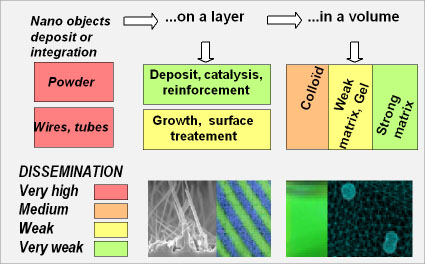
Dispersion capacity depends on the state of particles and the type of incorporation.
If the bulk powders have a strong propensity to disperse in an aerosol form (a phase of loading/unloading, for example) this propensity will be very strong.
On the surface, powders are deposited for reinforcement or catalyst while tubes or wires are produced by growth. The bonding force of the deposited particles is very important. The wires or tubes obtained by growth are more vulnerable than powders deposited, their ability to disperse is more important.
In a volume, the integration is done either in a liquid medium or in a gel or a flexible matrix, or in a solid matrix. The liquid solutions (colloids) of the nano-objects are often used as intermediate products. In a non permanent matrix or in a gel, the nano-objects are less firmly fixed than in a strong matrix (e.g., ceramics). The probability of dispersion of the nano-objects that depends on the bonding force with the integration support will therefore be very important for dry powders, medium in a colloid, low or very low in other cases.


